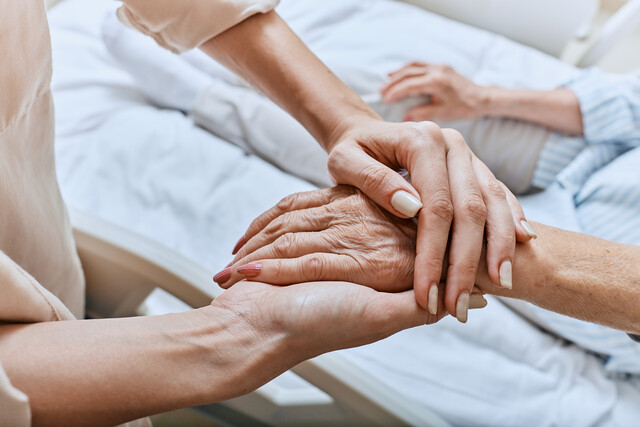Introduction
While more seniors are choosing to remain at home as long as possible and taking advantage of community options and resources for senior care, others do so because they have no other choice. The increasing costs of assisted living, home healthcare and nursing home scenarios are cost prohibitive to many, especially those who are not covered by private insurance or those who find that Medicare programs don't cover specific services.
It's especially important to be aware of patient care for those in a home-based setting because services are less frequent and don't provide nearly the monitoring and supervision as other scenarios such as long-term care centers or nursing homes.
For you to be an informed and an effective elder care advocate, it's important to be aware of the most important aspects of senior health and wellness, prevention of harm, and the resources available to provide the best patient care possible.
Patient Care Advocacy at Home
Family members, friends, and professional senior advocates can help make aging in place safer for seniors by paying attention to a variety of conditions and scenarios. Some of the most common include but are not limited to:
-
Adequate nutrition.
-
Access to medical care.
-
Access to at least one hot meal a day.
-
Availability of transportation to senior service centers or other venues for social interaction.
-
Medication supervision.
-
Resources for those diagnosed with anxiety, depression, or dementia.
-
Financial aid or legal counsel.
-
Community services.
Patient care in home-based scenarios provides unique challenges to family members and caregivers. The physical, emotional, mental, and financial demands placed on family members and caregivers can be enormous. The necessity of providing 24-hour care to individuals diagnosed with dementia or Alzheimer's is often overwhelming.
Such challenges may often lead to neglect, resentment, or inadequate care provided to seniors living in isolated or otherwise solitary conditions. As an advocate, it is your responsibility and obligation to ensure that quality care is available to seniors living alone, with adult children, in group homes, assisted nursing facilities, or even nursing homes within your community.
Education and information for seniors and their families and caregivers, regarding community resources and services is one of the most effective ways of ensuring quality of care for seniors at home. Creating a list and making it available to families requiring home healthcare providers, nurse's aides, therapists, and geriatric care managers may also help families take better care of their loved ones at home.
The Importance of Nutrition for Seniors
The dietary needs of seniors are different from young or middle aged adults. Seniors often experience a gradual decline of appetite and calorie needs, but that also depends on their activity levels. Some seniors today cut back on meals to save money. Those diagnosed with mild to moderate forms of dementia may literally forget to eat. On the other end of the spectrum, seniors who don't exercise or those who live relatively sedentary lifestyles may suddenly find themselves overweight or obese, leading to additional medical problems and complications including arthritis, diabetes, high blood pressure, and for some, difficulty in moving.
Large numbers of seniors are diagnosed with vitamin or other nutritional deficiencies. Two of the most common concerns regarding nutrition and the elderly are weight loss and malnutrition. According to studies, nearly one-fourth of seniors in the United States are considered malnourished. You don't have to be down to skin and bones to be malnourished. Malnourishment in seniors is often overlooked because healthcare providers are more concerned with the overall physical appearance and health of major body organs.
It's up to advocates, family members, and caregivers to be aware of a specific senior's dietary and eating habits and pay attention to any weight gain or weight loss as well as conditions that may affect appetite. Seniors may develop swallowing or eating difficulties that lead to inadequate nutrition.
Patient advocates should do their best to make sure those caregivers and family members understand the basics of senior nutrition. The dietary recommendations by their doctor should be followed. Patients on low-sodium, low-sugar, or low-fat diets should be following their diet in order to reduce complications of cardiac conditions or diabetes.
Physical changes in seniors may reduce their appetite, and sedentary lifestyles decrease appetite. Many seniors in nursing homes find food served as unappetizing, while seniors at home may increasingly choose microwavable dinners or canned food out of convenience and financial necessity. Such foods are often extremely high in sodium and low in nutritional value.
Seniors who are lonely or depressed may also resist eating or eat too much. Medications can change the appetite as well as the taste of many foods. A knowledgeable advocate will be able to understand the connection between medical conditions, medications, and diet in order to ensure that adequate nutrition is achieved.
Some resources regarding diet and nutrition for the elderly can be accessed from the American Dietetic Association, the USDA Food and Nutrition Information Center, the Federal Government's Nutrition Website, and the Nutrition Hotline of The American Institute for Cancer Research, among many others.
An advocate is aware of the changes in physical makeup of seniors such as loss of smell, a diminishing sense of smell, changing tastes, and an individual's inability or lack of desire to cook well-rounded and nutritious meals in a home environment, especially if they are living by themselves.
A senior advocate should ensure that seniors gain adequate nutrition from basic food groups including vegetables, fruits, grains, and protein sources. For example, senior dietary requirements suggest that a rather sedentary woman over 50 requires roughly 1,600 calories a day. A very active woman over 50 will require roughly 2,000 calories a day. At the same time, a very active man over 50 requires between 2,400 and 2,800 calories a day.
Still, nutrition is more than mere calorie counting. A senior food pyramid should involve all colors of the rainbow. For example, vegetables high in color such as dark greens, oranges, yellows, and reds provide a wide variety of antioxidants, vitamins, and minerals. Roughly, 2 to 2 1/2 cups of vegetables servings are recommended for seniors on a daily basis.
Seniors require protein of about 0.5 g per pound of their body weight. For example, a woman who weighs 130 pounds should ingest roughly 65 grams of protein every day. Common sources of proteins include fish, cheese, milk, eggs, nuts, meats, and seeds.
Seniors require between 6 and 7 ounces of grains a day. One slice of bread measures to approximately 1 ounce. Seniors require adequate calcium to help prevent degeneration of bone and joint health, prevent fractures, and osteoporosis. Seniors should ingest roughly 1,200 mg (1.2 g) of calcium every day.
Fruits are also an excellent source for vitamins and fiber. One to two servings of fruit a day is recommended for seniors.
As a senior advocate, one of the most important things to remember is that every individual should have access to adequate amounts of water every day. Adequate amounts of water help prevent confusion in seniors as well as preventing constipation and urinary tract infections. Water should be made available every hour of the day, though some individuals need to regulate their fluid levels.
Access to Medical Care
Access to medical care is everyone's right. Whether a senior is on public health assistance, has private medical insurance, or Medicare, he or she should have full access and transportation to their doctors' offices, to pick up medications, and to have access to emergency medical services when necessary.
Community resources should be made available to all seniors in the community to facilitate such access. Many rural communities offer public transportation or senior van or bus transportation for seniors in order to facilitate their health and wellness.
Elderly patient advocates, whether they're private volunteers or members of the community, a caregiver, or work with the public health and services department, a local hospital, or senior community resource, have the opportunity to address such needs.
Conclusion
Ensuring the security, safety, and access to community services for individuals aging in place in home or private environments is the responsibility of every community. The availability of home-based care when compared to the care provided in larger or more structured facilities such as assisted living or nursing home locations provide advocates more challenges to oversee and maintain proper and quality care.
Introduction
There is probably more attention paid to advocacy for elders in nursing homes than in any other scenario. This is a good thing, as many seniors and their family members don't have a concrete idea of what to expect from nursing home care or how to evaluate a nursing home; they do not understand or ask about policies against abuse.
As an elder patient advocate, this area of senior care is one that offers a variety of opportunities and information for aging parents and family members. It's also a very good opportunity for advocates to instruct and remind nursing and support staff in all caregiving situations not only of a resident's rights, but to continually strive for excellence in quality care.
Expectations of Care
Expectations of care can be defined as what a senior family member expects in a nursing home, an assisted living facility, or through services obtained by a home health care agency. Understanding the basic requirements regarding care as offered by local, state, and Federal governments will help you make wise decisions regarding elderly care, and may involve active advocacy for the elderly in situations where such care is lacking.
Communication, knowledge, and a willingness to discuss concerns, complaints, and expectations of care will help improve standards and quality of care everywhere. Expectations of care may depend on the length of time an individual needs home health care or is placed in a nursing home or long-term care center environment.
For example, an elderly woman may need rehabilitation and short-time supervision following surgery and release from the hospital. Such individuals are often released to long-term care or rehabilitation centers for physical therapy. Alternatively, an elderly man diagnosed with Alzheimer's may need to be placed in a nursing home because his home environment is no longer safe for him. Expectations regarding care and services will differ between each of these scenarios.
Levels of care will also differ depending on circumstances, the elderly patient's current physical and cognitive abilities, their needs, and doctors' orders. The type of care, the level of care, help with transferring, and the mental status of a patient will determine what types of care is available in each case.
When it comes to expectations of care, any type of caregiving facility or agency should offer, at the minimum:
-
Licensure or certification by state government.
-
Background checks on employees that meet state requirements.
-
Specialized services, including rehabilitation, hospice care, Alzheimer's units, and others.
-
Adequately trained staff.
-
Protection against theft and abuse.
These are basic expectations that most people have regarding the safety and security of loved ones in a nursing home or those requiring specialized therapy or nursing care in home-based environments. If such standards are not met, patient advocates may help resolve some of these issues and document discrepancies on the part of a nursing home, or to educate family members regarding rules and regulations as offered by state governments.
A patient advocate may be consistently required to serve as a bridge between medical providers and the elderly patient and their families. Patient advocates strive to work with all parties involved to improve levels of care and to ensure that not only rules and regulations are being followed, but that the needs as well as the considerations and concerns of medical providers are also met and addressed.
Evaluating a Nursing Home
An elderly patient advocate can help family members become more familiar not only in regard to expectations of care for elders in nursing homes, but also in evaluating nursing homes for their loved ones.
Advocates pay attention to more than whether floors are clean, walls are painted, or the beds are comfortable. Elderly patient advocates continually strive to improve communications, patient access, and quality of care. Basic quality of life issues are the focus of elderly patient advocates. For example, an elderly patient advocate may:
-
Ensure that residents and staff members in any facility are cordial, respectful, and maintain the dignity of the elderly.
-
Ensure that visiting hours are adequate so that patients and their families have ample opportunity to socialize.
-
Ensure that the religious, cultural, or language needs of senior residents are being met.
-
Enable residents to have adequate choices regarding when they get up, when they go to bed, when they eat, bathe, and how they fill their day or evening.
When it comes to quality of care, a patient advocate can ensure that nursing home staff responds quickly to call lights and patient concerns. The patients should always have access and transportation to their doctor or dentist's office. Adequate staffing is also something to consider, and family members should visit nursing homes during the daytime, the evening, on weekends, and holidays to determine patient to staff ratios.
Safety of residents is of primary importance to all caregivers, advocates, patients, and their families. For example, handrails should be available in all hallways and every bathroom should be equipped with a grab bar. Hallways should be free of clutter that can cause fall hazards. Hallways should also be adequately lit during daytime and nighttime hours. Every nursing home, assisted living facility, or adult day care center should have smoke detectors and a working sprinkler system on the property.
Elderly care advocates are also especially aware of the use of physical restraints in nursing home scenarios. Restraints such as lap cushions and seat belts are often necessary in order to protect and ensure the safety of the senior. However, if family members are at all concerned that their loved ones are being inappropriately restrained or prevented from leaving their room, joining in on facility activities, or access to outside environments, the patient advocate is responsible for investigating and ensuring that family concerns are being addressed.
Policies against Abuse
When inspecting a nursing home for a loved one, ask to see a copy of the facilities policies against abuse. Every nursing home, home health care, or assisted-living facility should have policies in place regarding the ramifications of any type of abuse by staff members or even family members within the facility.
Patient advocates are especially aware and alert to concerns of family members as well as residents and staff members regarding the topic of abuse, suspected abuse, or situations that may increase the risk of abuse in a variety of scenarios.
Elderly patient advocates should be aware of the different types of abuse that may occur in a nursing home environment. While it is not common to find instances of fraud, power of attorney abuse, financial abuse, or sexual abuse in nursing homes, the fact is, it can happen.
Two of the most common forms of abuse that occur in nursing facilities today include physical abuse, such as the use of restraints, forced feeding, and ignoring or otherwise verbally abusing or hurting the feelings of a resident.
Another form of abuse in nursing homes today is medical abuse, meaning that patients may be given the wrong medication, not receive adequate individualized medical attention, and in some cases, may experience billing fraud.
The truth is that the continually changing medical care needs of seniors in nursing homes are, if not ignored, often neglected. Many seniors are hesitant to complain about new aches and pains, side effects of medications, or feelings that they are over-medicated. Many seniors don't realize that their physical condition has changed, that they have become frailer, or that their mental cognition has changed. A growing sense of confusion among the elderly may prevent them from being able to adequately express their own concerns.
Often, it's left to family members to notice these changes. However, what of the residents who don't have regularly visiting family members, friends, or relatives who stop by to notice such changes?
Nursing staff often perform regular assessments on patients, but careful follow up with doctors and specialists is often lacking. Some of the most common medical abuses may include:
-
Over medication or under medication.
-
Lack of adequate care or follow up due to reduction of staff members in a nursing home.
-
Medical negligence on the part of doctors.
-
Neglect of a patient's personal hygiene.
-
Lack of dental or vision care such as an increased need to refit dentures, or renew a prescription for glasses.
Conclusion
It can be said that the majority of nursing staff in nursing homes strive their best to take care of the needs of their elderly residents. Unfortunately, understaffing, budget cuts, and increased confusion regarding prescriptions, restraints, and assessments often contribute to miscommunication, lack of adequate follow up, and apathy when it comes to dealing with many patient needs in nursing homes.




























